ISO-NE marks Earth Day 2017 with an update on the effects of clean-energy initiatives in New England
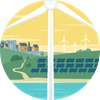
This Earth Day (Saturday, April 22)—or any day—you can learn about the role that renewables and other clean-energy resources are playing in the region by visiting ISO New England’s Key Grid and Market Stats and Grid in Transition webpages. Following are some snapshots of where the region stands, with links to learn more.
Generator air emissions have fallen dramatically
For over a decade, the region’s shift to natural-gas-fired generation, as well as emission controls on fossil-fuel-fired power plants, has created significant overall reductions in the region’s annual generator air emissions. Several factors, though, including increasing oil-fired generation during winter due to natural gas pipeline constraints and the retirement of nuclear generation, have contributed to some slowdowns in declines recently—and even some year-over-year upticks. Read more on Key Stats: Air Emissions and Resource Mix.
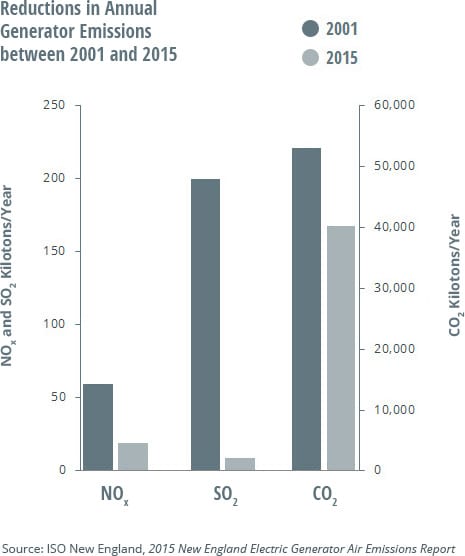
The New England states have set aggressive goals
As shown below, State Renewable Portfolio Standards require electricity suppliers to provide customers with increasing percentages of renewable energy. The New England states are also promoting greenhouse gas (GHG) reductions of 75%–95% below 1990 levels by 2050 on a state-by-state basis and at the regional level, through a combination of legislative mandates (e.g., CT, MA, and RI) and aspirational goals (e.g., ME, NH, VT, and NEG-ECP). (Some states have different baseline and target years.)
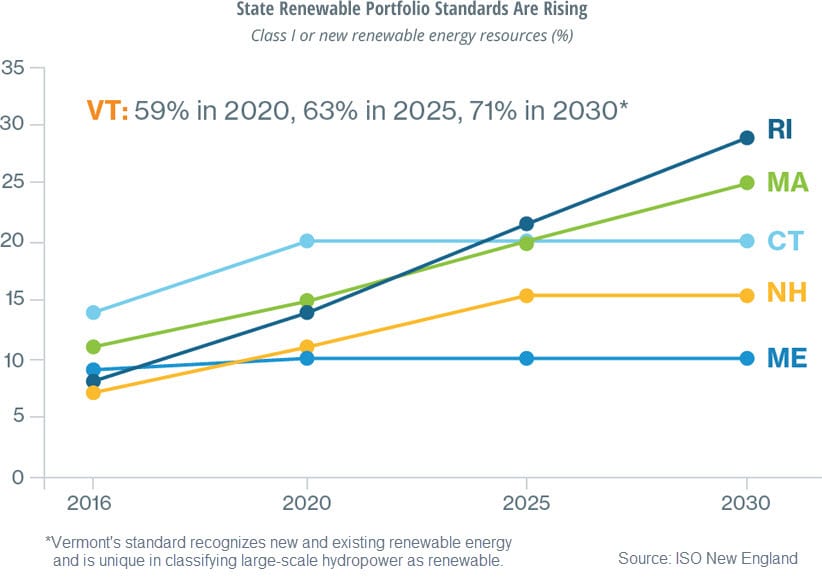
State policies like these, as well as state and federal support and tax credits and falling technology costs, are spurring remarkable growth in clean-energy resources. But they also have long-term implications for the competitive wholesale electricity marketplace’s ability to attract and sustain reliable sources of electricity. Learn more.
Energy-efficiency measures and solar power are reducing grid demand
 The states have also been investing heavily in energy-efficiency (EE) programs, which reduce demand from the power system using measures such as more efficient lighting, appliances, and heating, cooling, and ventilation equipment, as well as with energy management systems. The American Council for an Energy-Efficient Economy’s State Energy Efficiency Scorecard ranks most New England states in the top 5 across the nation.
The states have also been investing heavily in energy-efficiency (EE) programs, which reduce demand from the power system using measures such as more efficient lighting, appliances, and heating, cooling, and ventilation equipment, as well as with energy management systems. The American Council for an Energy-Efficient Economy’s State Energy Efficiency Scorecard ranks most New England states in the top 5 across the nation.
The US Environmental Protection Agency calls improving EE “one of the most constructive and cost-effective ways to address the challenges of high energy prices,… air pollution, and global climate change.” Also serving to reduce the amount of electricity being pulled from the regional grid are the region’s rapidly multiplying solar photovoltaic (PV) systems, the vast majority of which are installed “behind the meter” directly at consumer sites or utilities across the region.
To capture the long-term effects of these demand-reducing resources, the ISO developed the nation’s first multi-state energy-efficiency and solar PV forecasts in 2012 and 2014, respectively, and updates them annually. The graphs below reflect draft data for the upcoming 2017 forecasts. They illustrate how EE and PV are helping to reduce total annual grid demand and are keeping the growth of peak demand—the hour of highest electricity use—flat. Learn more on Key Stats: Electricity Use.
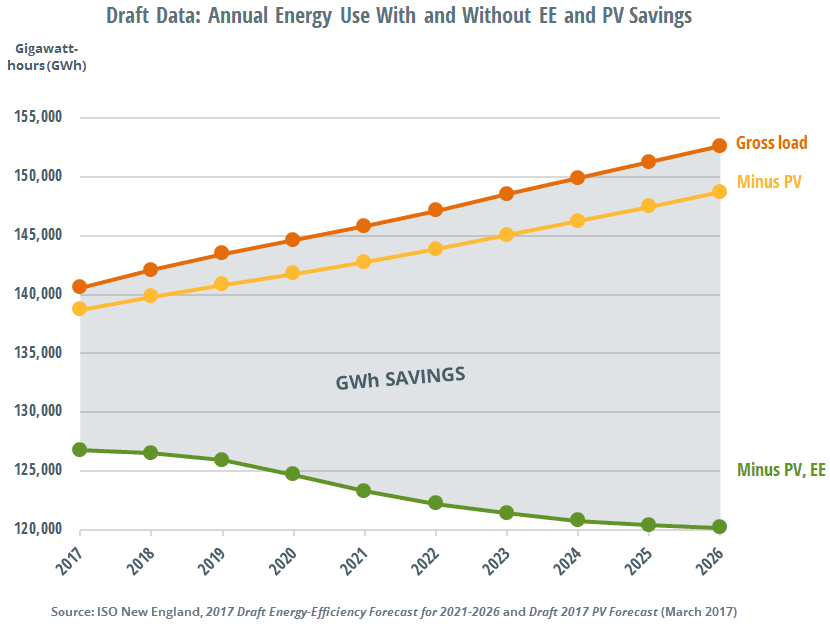
 The gross load forecast (projected regional energy use)
The gross load forecast (projected regional energy use)
 The gross load forecast minus forecasted behind-the-meter (BTM) solar photovoltaic (PV) resources
The gross load forecast minus forecasted behind-the-meter (BTM) solar photovoltaic (PV) resources
 The gross load forecast minus forecasted BTM PV, minus energy-efficiency (EE) resources in the Forward Capacity Market (FCM) 2017–2020 and forecasted EE 2021–2026
The gross load forecast minus forecasted BTM PV, minus energy-efficiency (EE) resources in the Forward Capacity Market (FCM) 2017–2020 and forecasted EE 2021–2026
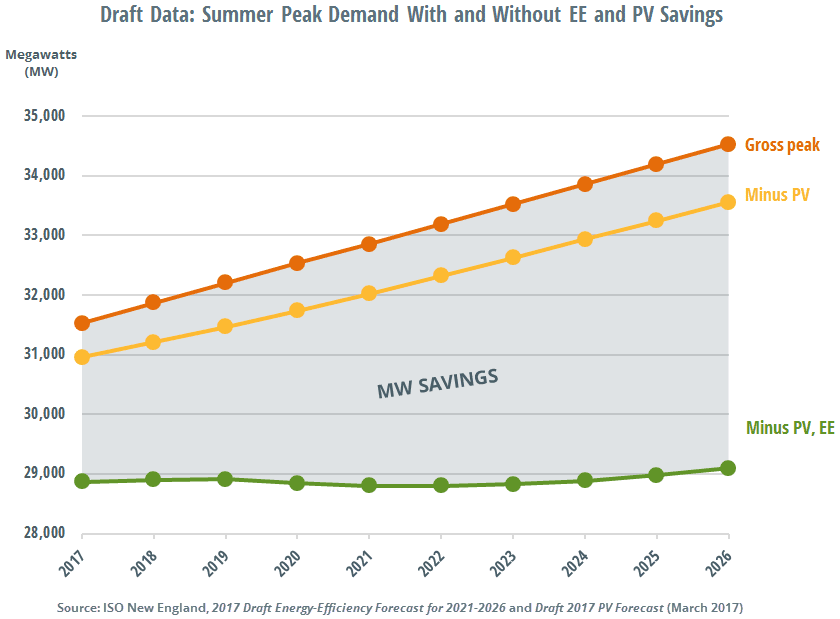
Note: Summer peak demand is based on the “90/10” forecast, which accounts for the possibility of extreme summer weather, such as an extended heat wave of about 94°F.
Clean-energy resources are playing a growing role
In 2016, hydro and renewable resources located regionally contributed 6% and 8%, respectively, of the electricity pulled from the grid, while imported electricity—most of it Canadian hydro power—contributed about 17%. And the amounts of renewable power resources and energy-efficiency measures in New England are projected to continue growing rapidly, as the chart below shows. It will be many years, though, before those resources can match the amount of natural gas capacity currently on the system and proposed for development.

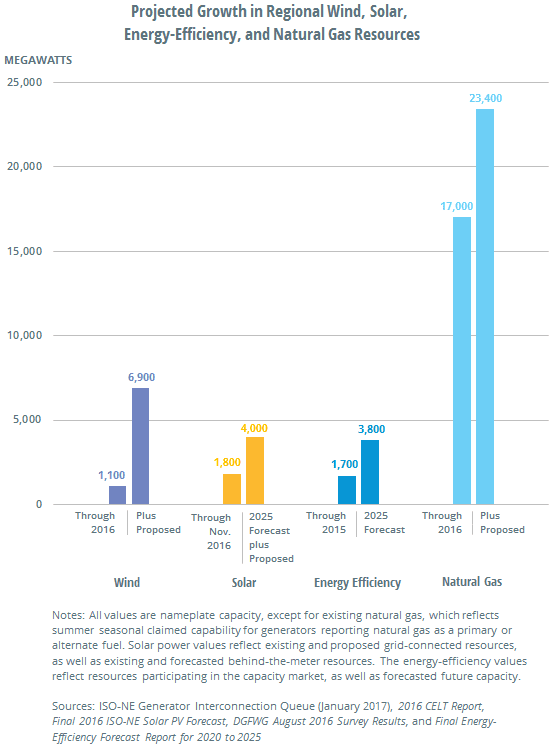
Of note in the region’s additions of clean-energy resources: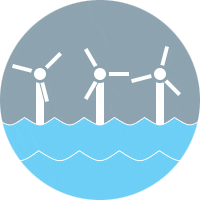
- The nation’s first offshore wind farm began delivering electricity off the cost of Rhode Island in December 2016 and is paving the way for similar projects to harness New England’s significant offshore wind energy potential. Read more.
- In late 2015, grid-scale battery-storage projects requested interconnection to the regional power system for the first time, with 16 MW achieving commercial operation by late 2016 and almost 80 MW more in the ISO Generator Interconnection Queue as of April 2017. Read more.
Interconnecting more wind power will take transmission improvements
Wind power projects make up 43% of all proposed new generators in New England. But because of the large distances from some of the proposed onshore wind power projects to the existing grid, major transmission system upgrades will be needed to deliver more of this power to far-away consumers. Proposed offshore wind projects closer to New England load centers may require fewer upgrades to the existing grid, but building wind turbines offshore is typically more costly than placing them on land. Read more on Key Stats: Transmission.
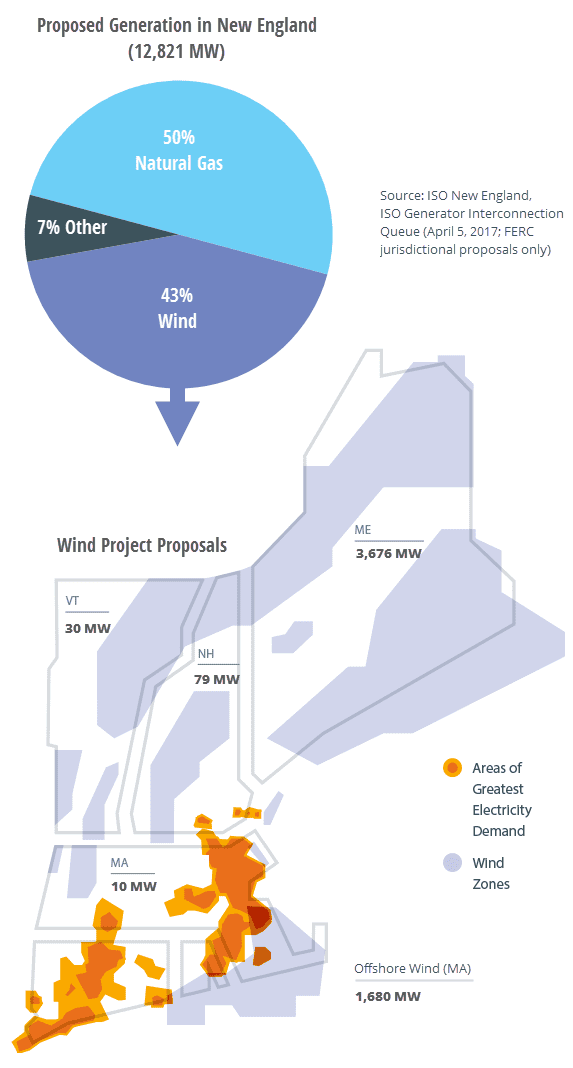
The ISO is working to integrate more renewable resources
To be able to integrate large amounts of clean-energy resources while ensuring the reliable operation of the grid, the ISO has had to make adjustments across nearly every aspect of its work. Accounting for the weather-dependent generation from wind and solar resources is requiring innovative new approaches, for example. From grid operations to the wholesale electricity marketplace to long-term system planning, we’re pursuing initiatives—and sometimes pioneering new approaches—to help the region keep pace with rapidly changing technologies. Learn more in:
- Categories
- Industry News & Developments
- Tags
- energy efficiency, energy storage, environment, forecast, renewable resources, solar, wind



